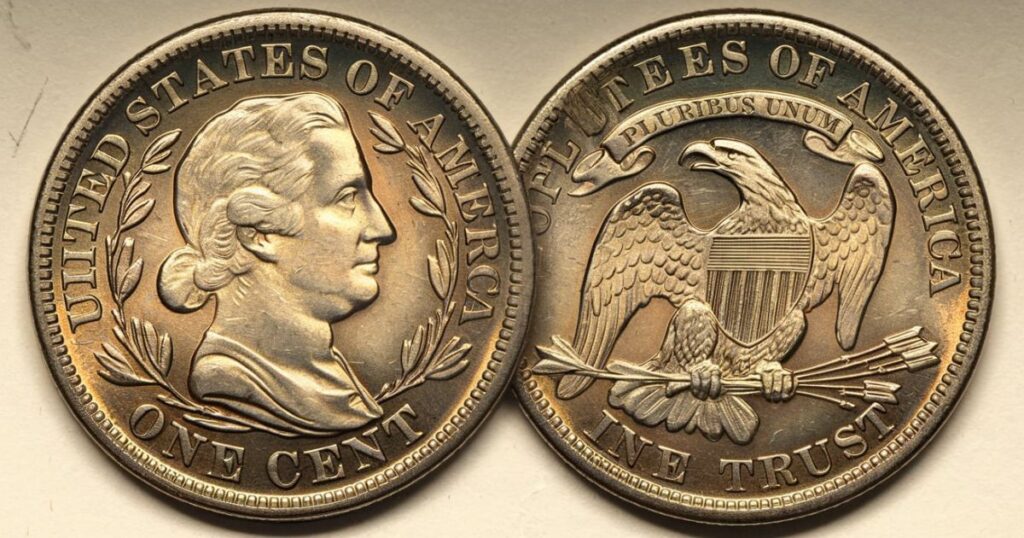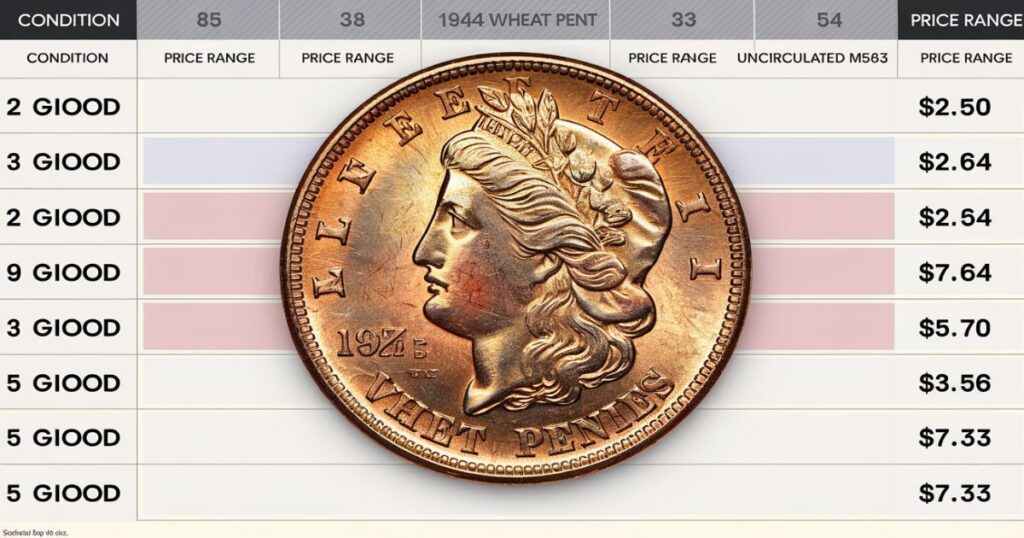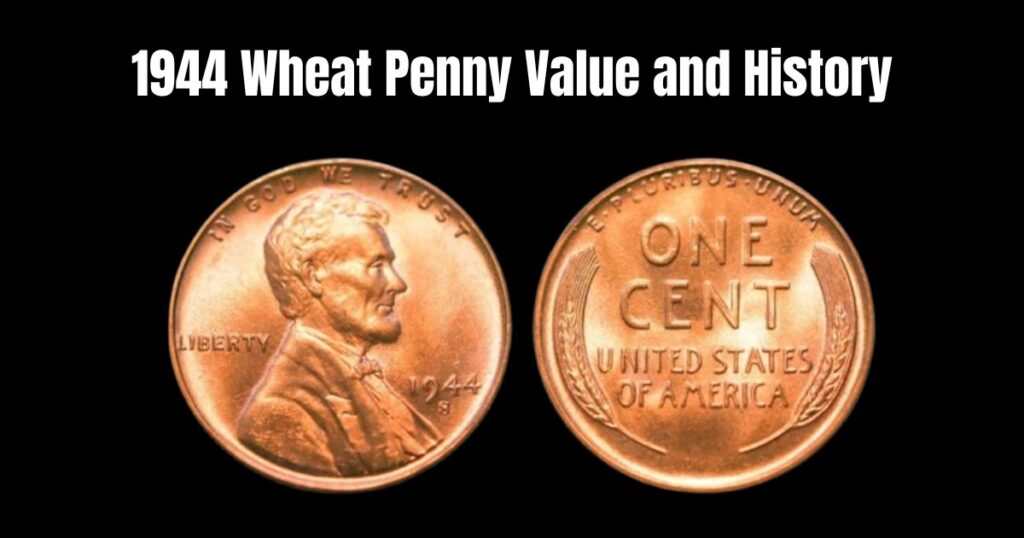The fascinating world of coin collecting holds a special place for the 1944 Wheat Penny, a remarkable piece that transcends its humble origins as everyday currency.
These extraordinary coins, bearing the dignified portrait of Abraham Lincoln, have evolved from simple pocket change to highly coveted collectibles worth anywhere from a few US dollars to staggering six-figure sums.
Their unique place in American history, combined with their scarcity and distinctive characteristics, makes them a centerpiece of serious numismatic collections.
What is the 1944 Wheat Penny?

The 1944 Wheat Penny represents a pivotal moment in American minting history. These coins emerged from three distinguished facilities: the Philadelphia Mint, Denver Mint, and San Francisco Mint.
Each penny was crafted with meticulous attention to detail, featuring a precise 19:1 ratio of copper to zinc. This specific composition gave the coins their distinctive appearance and durability that collectors cherish today.
The design elements of these pennies tell a compelling story of American craftsmanship. On the obverse, Abraham Lincoln’s profile sits with dignified grace, while the reverse showcases the iconic wheatgrass impression that gives these coins their popular name.
The artistry involved in creating these details helped establish their enduring appeal in the collector’s market, making them highly sought-after pieces for both novice and experienced collectors alike.
History of the 1944 Wheat Penny
The emergence of the 1944 Wheat Penny followed a tumultuous period in American coinage. The preceding 1943 coins, made primarily of steel due to wartime copper shortages, had proven problematic.
Their zinc coating wore off easily, and their silver appearance often led to confusion with dimes. This public dissatisfaction catalyzed significant changes in penny production, as documented by esteemed numismatic scholar Roger W. Burdette.
What makes these coins particularly fascinating is their connection to World War II. As renowned numismatic experts have noted, the copper used in these pennies often came from recycled ammunition shells, creating a unique bridge between military history and civilian currency. This innovative solution to wartime material shortages adds an extra layer of historical significance to these remarkable coins.
1944 Wheat Penny Current Value
The value of the 1944 wheat penny can vary significantly based on its condition, ranging from as low as 15 cents to as much as $20,000, influenced by several factors.
While many believe that only copper wheat pennies were minted in 1944, the reality is more complex. Over time, it was discovered that there are actually three types of coins bearing the 1944 date: steel wheat coins, silver coins, and D/S wheat coins.
1. 1944-D/S Wheat Coins
The 1944-D/S Wheat Coins stand as some of the most valuable errors in American numismatics. These rare specimens, featuring an overlapped Denver Mint and San Francisco Mint mark, demonstrate a fascinating minting error that has captured collectors’ imagination.
Their value typically ranges between $50,000 and $60,000, with exceptional specimens commanding even higher prices in the collector’s market. The rarity of these double-marked pieces makes them particularly prized among serious collectors seeking unique additions to their collections.
2. 1944 Steel Wheat Coins
The existence of 1944 Steel Wheat Coins represents one of the most intriguing transitional errors in American coinage. According to the respected NGC Price Guide, these rare specimens can fetch between $35,000 and $43,000 in typical condition.
However, examples in pristine condition have achieved the remarkable price of $175,000 in open market sales. These coins emerged when leftover steel planchets from 1943 were accidentally fed into the 1944 production line, creating an unintended but highly valuable variety.
3. 1944 Silver Coins
Despite their misleading name, 1944 Silver Coins are actually steel-based pieces with a distinctive lustrous appearance. With only 50 known examples in circulation, they represent the apex of wheat penny collecting.
The Philadelphia Mint specimens regularly command around $180,000 at auction, while a particularly remarkable San Francisco example once achieved an astounding $408,000. This variety stands as testament to the incredible values that rare mint errors can achieve in today’s market.
Read Also: Braxton Berrios Net Worth
How is the 1944 Wheat Penny Value Defined?
The worth of 1944 Wheat Pennies is influenced by several factors:
1. Mint Marks
The value of these historic pieces heavily depends on their origin within the U.S. Mint system. While the Philadelphia Mint pieces carry no distinctive mark, coins from the Denver Mint and San Francisco Mint proudly display their ‘D’ and ‘S’ marks respectively.
The San Francisco specimens are particularly valued in the numismatic community due to their limited production numbers. Advanced collectors often focus on acquiring examples from all three mints, with special attention paid to the condition of the mint marks themselves.
2. Condition
In the realm of coin condition, the difference between grades can mean thousands of dollars in value. Professional graders employ the MS (Mint State) system, with grades ranging from MS63 to MS68.
Each grade represents a specific level of preservation, with MS63 showing minimal wear and MS68 representing virtual perfection. The journey from uncirculated pennies to heavily circulated pennies tells a story of the coin’s life and significantly impacts its market worth.
The grading system considers multiple factors, including:
- Surface preservation
- Strike quality
- Remaining luster
- Color retention These elements combine to determine the final grade and, consequently, the coin’s value in the market valuation process.
3. Collectors Demand
The dynamic relationship between demand and supply fundamentally shapes the collector’s market for these pennies. Pieces featuring notable error classifications or scarce mint marks generate intense auctioneer demand. Current market trends show that specimens with double die characteristics or other distinctive features consistently command premium prices, reflecting strong collector’s interest in unique varieties.
4. Historical Significance
Coins minted during the crucial months of June, July, and August 1944 carry special historical value due to their connection with the Normandy battle. These pieces, produced while Allied forces fought for Europe’s liberation, embody a tangible link to one of history’s most pivotal moments. This connection to world-changing events adds considerable heritage value and legacy value to specimens from this period.
1944 Wheat Penny Value Chart

Understanding color designation is crucial for accurate market valuations. The three primary color designations in the collecting community are:
BN (Brown): These coins show the natural aging process of copper, with 5% or less red surface remaining. While they may command lower prices, original brown toning can be quite attractive.
RB (Red-Brown): Representing a transitional state, these pieces retain between 5% and 95% of their original red coloring, often creating stunning visual effects.
RD (Red): The most valuable designation, these coins maintain over 95% of their original red copper color, demonstrating exceptional preservation.
1944 Wheat Penny Value Chart
The following comprehensive price range details reflect current market valuations across various grades and conditions. These values represent typical market fluctuations in the collector’s market:
For Philadelphia Mint (No Mint Mark):
- RD specimens in MS63: $8-10
- RD in MS67: $175-225
- RD in MS68: $12,000-14,000
For Denver Mint (‘D’ Mark):
- Standard RD in MS63: $10-12
- Premium RD in MS67: $300-325
- Exceptional RD in MS68: $9,000-10,000
For the rare Steel Wheat Coins:
- Philadelphia issues: Up to $175,000
- Denver variants: Approximately $43,000
- San Francisco examples: Up to $475,000
Identification of a Real 1944 Wheat Penny
Authentication remains crucial in the numismatic community. A genuine 1944 Wheat Penny exhibits specific coin characteristics that serious collectors must understand. The portrait of Abraham Lincoln should show precise detail, particularly in the beard and hair areas. The date “1944” must display consistent font style and spacing characteristic of genuine U.S. Mint products.
The penny composition plays a crucial role in authentication. Standard issues contain the specific copper and zinc ratio, while rare steel variants exhibit distinct metallic properties. Professional dealers often employ magnetic testing, as steel versions will attract magnets while standard copper examples won’t. This simple test can provide initial insight into a coin’s authenticity.
The wheatgrass impression on the reverse side requires careful examination. Authentic pieces show clear, well-defined wheat stalks with precise spacing and detail. The lettering should appear crisp and properly aligned, maintaining consistent spacing throughout the design. Any deviation from these standards might indicate a counterfeit piece in the collector’s market.
Understanding mint marks is essential for proper coin appraisal. When present, these marks must show appropriate size, style, and positioning for their respective mints. The Denver Mint mark appears as a clear, well-defined “D,” while the San Francisco Mint mark shows as a distinct “S.” Philadelphia-minted pieces carry no mint mark, but this absence should appear natural rather than altered.
Read Also: Jeremy Jr. Robinson Net Worth
Conclusion
The 1944 Wheat Penny stands as a testament to American numismatic heritage, representing both historical significance and potential investment value. From modest beginning values to specimens worth over $475,000, these coins continue to captivate collectors and historians alike. Their numismatic value extends beyond mere monetary worth, encompassing crucial aspects of American history during World War II.
For those entering the world of coin collection, understanding the various factors affecting these pennies’ value proves essential. Whether considering them for investment purposes or historical interest, their enduring appeal in the numismatic community remains undeniable. The combination of rarity, historical significance, and potential appreciation continues to drive strong collector’s interest.
As market trends evolve and new discoveries emerge, the fascination with these coins only grows stronger. Their connection to a pivotal moment in American history, combined with their varying degrees of rarity and condition, ensures their lasting place in numismatics. Whether you’re a seasoned collector or newcomer to the field, the 1944 Wheat Penny represents an enduring piece of American heritage worth studying and preserving.
Remember that proper evaluation through professional appraisal process remains crucial for any serious transaction. The world of coin collecting continues to appreciate these remarkable pieces, ensuring their place in both American history and the future of numismatics. Their story serves as a reminder of how seemingly ordinary objects can transform into extraordinary treasures, carrying both historical significance and substantial monetary value for future generations.
FAQ’s
What makes a 1944 wheat penny so rare?
The 1944 wheat penny’s rarity stems from its unique wartime production using recycled bullet shells and several notable errors, particularly the steel variants which were accidentally produced when leftover 1943 steel planchets were used.
How much is a 1944 wheat penny worth today?
A regular 1944 wheat penny in circulated condition is worth 15 cents to $6, but rare varieties like the steel penny can fetch up to $175,000, while the prized 1944-S steel penny has sold for as much as $408,000.
What makes a 1944 steel wheat penny valuable?
The 1944 steel wheat penny is extremely valuable because it was created in error when leftover steel planchets from 1943 were accidentally used instead of the standard copper composition, with only about 30 known examples existing today.
What is the rim error on a 1944 penny?
The rim error on 1944 pennies appears as a raised or uneven edge caused by improper striking during minting, often creating a distinctive “fin” or “wing” effect along the coin’s rim.
Why does my 1944 wheat penny not stick to a magnet?
Your 1944 wheat penny doesn’t stick to a magnet because it’s made of the standard copper-zinc alloy (95% copper); only the rare steel variants from 1944 (worth thousands) would show magnetic properties.
What is a 1944 shell case penny?
A 1944 shell case penny was made from recycled World War II ammunition shells melted down to create copper planchets for penny production, representing a unique connection between military history and civilian currency.









